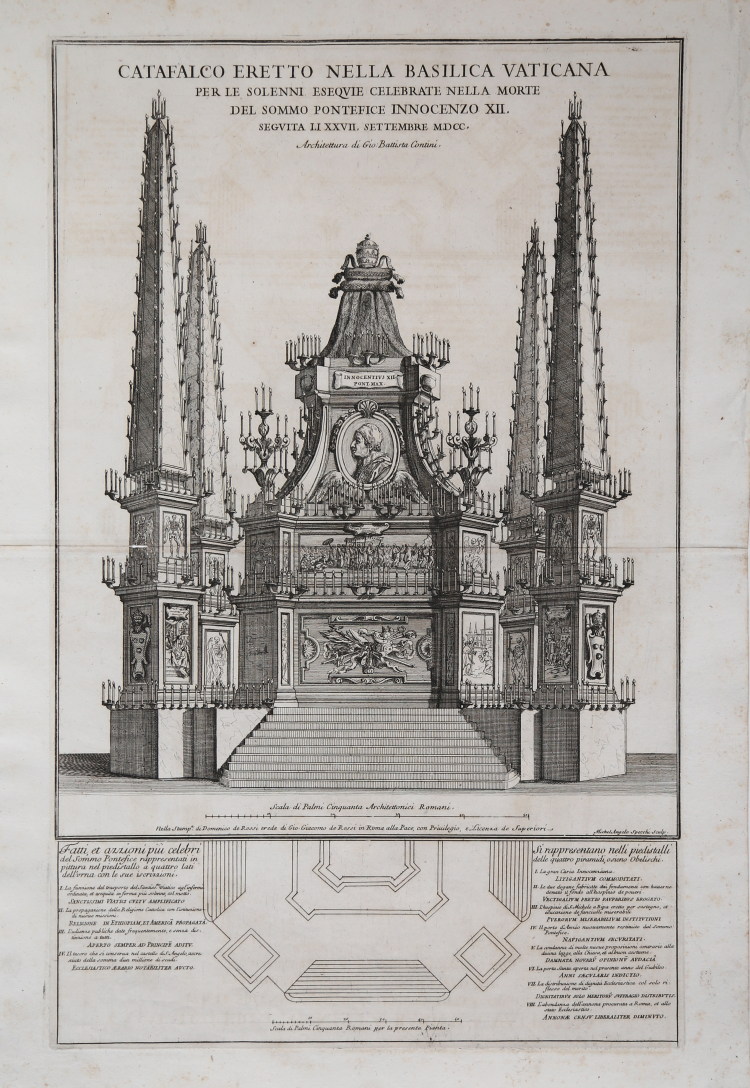- New




| Reference: | S52129 |
| Author | Michelangelo SPECCHI |
| Year: | 1700 |
| Printed: | Rome |
| Measures: | 355 x 580 mm |



| Reference: | S52129 |
| Author | Michelangelo SPECCHI |
| Year: | 1700 |
| Printed: | Rome |
| Measures: | 355 x 580 mm |
CATAFALCO ERETTO NELLA BASILICA VATICANA PER LE SOLENNI ESEQUIE CELEBRATE NELLA MORTE DEL SOMMO PONTEFICE INNOCENZO XII, SEGUITA LI XXVII SETTEMBRE MDCC. Architettura di Gio. Battista Contini.
Etching, 1700, signed on the plate lower right "Michelangelo Specchi Sculp.".
It depicts the catafalque erected in the Vatican for the funeral of Pope Innocent XII, born Antonio Pignatelli di Spinazzola (1615-1700), celebrated on September 27, 1700. The design was by the architect for Giovanni Battista Contini.
The report (see G. Buagni, Distinta relazione del nobilissimo catafalco…Roma, 1700) on the pontiff's funeral states that the choice of architect for the catafalque was made in favor of Giovanni Battista Contini (1642-1723), then the architect of the conclave, after Domenico de Rossi and Francesco Fontana withdrew. According to protocol, the catafalque was to be presented nine days after the pontiff's death, or October 6, but the event was postponed to October 9. For Contini, the catafalque was the third monumental funeral monument he created in memory of a pontiff, following those of Alexander VII in 1667 and Clement IX in 1669.
The catafalque was designed according to the traditional scheme, consisting of a central body, containing the urn and the tiara, and four lateral pyramids whose pedestals depicted the four most important achievements of Innocent XII's pontificate: the Curia of Montecitorio; the Customs House and the Customs House; the Hospice of San Michele for orphans; and the port of Anzio. The lighting system used 1,200 candles, compensating for the low refraction of the yellow and gray shades used to paint the structure.
A magnificent work, printed on contemporary laid paper with margins, a small wormhole along the central fold, and minimal oxidation, otherwise in excellent condition. Rare.
Bibliografia
Il catafalco d'Innocenzo XII dell’architetto Giovanni Battista Contini, in “Dall'Archivio segreto vaticano: miscellanea di testi, saggi e inventari”, II, Città del Vaticano, 2007, pp. 275-292; S. Tozzi, Incisioni barocche di feste e avvenimenti, p. 131.
Michelangelo SPECCHI (Roma 1684 - 1750 circa)
|
Michelangelo Specchi was an Italian architect, born in 1684. If he was a relative of the architect Alessandro Specchi (1668-1729), he was not known. Michelangelo Specchi is mentioned in the years 1702-1703 as a member of the artists' association Accademia di San Luca . In the Academy there is an architectural drawing from his hand dated 1703. In 1722, in Rome, the so-called Festa della Chinea was re-introduced to the Pope of the Kingdom of Both Sicily. The party was held on Piazza dei Santi Apostoli in front of Palazzo Colonna, where the ambassador from Naples lived. The culmination at the party was a big party fireworks fired from the splendid and imaginative giant scenes and pieces that were used for this purpose in the square in front of the palace. The first costly scene was performed after Alessandro Specchi 's drawings and in 1739 Michelangelo Specchi's turn was to stand for the decoration together with Pierre-Ignace Parrocel. The motif was this time the Parnasset with Apollon, the Mice and Pegasus, whose main battle was given the source of the Hippocrates to jump from the rock on the mountains of Helikon. Pieces of this scene as well as another with the theme "Felicitas Publica" can be seen in the Archivi di Teatro Napoli . In 1725 or 1737, Michelangelo Specchio made the monstrous of the high altar in the Church of Santa Maria in Campitelli. Acc. Allgemeine Künstlerlexikon Michelangelo Specchi also stood for a rebuilding of the altar of the San Marco Church at Piazza Venezia. Shortly before his death in 1750, Specchi drew the new facade to the little church of Santa Maria del Carmine, all Tre Cannelle , which was at the time undergoing rebuilding. Michelangelo Specchi died at a time after 1750.
|
Michelangelo SPECCHI (Roma 1684 - 1750 circa)
|
Michelangelo Specchi was an Italian architect, born in 1684. If he was a relative of the architect Alessandro Specchi (1668-1729), he was not known. Michelangelo Specchi is mentioned in the years 1702-1703 as a member of the artists' association Accademia di San Luca . In the Academy there is an architectural drawing from his hand dated 1703. In 1722, in Rome, the so-called Festa della Chinea was re-introduced to the Pope of the Kingdom of Both Sicily. The party was held on Piazza dei Santi Apostoli in front of Palazzo Colonna, where the ambassador from Naples lived. The culmination at the party was a big party fireworks fired from the splendid and imaginative giant scenes and pieces that were used for this purpose in the square in front of the palace. The first costly scene was performed after Alessandro Specchi 's drawings and in 1739 Michelangelo Specchi's turn was to stand for the decoration together with Pierre-Ignace Parrocel. The motif was this time the Parnasset with Apollon, the Mice and Pegasus, whose main battle was given the source of the Hippocrates to jump from the rock on the mountains of Helikon. Pieces of this scene as well as another with the theme "Felicitas Publica" can be seen in the Archivi di Teatro Napoli . In 1725 or 1737, Michelangelo Specchio made the monstrous of the high altar in the Church of Santa Maria in Campitelli. Acc. Allgemeine Künstlerlexikon Michelangelo Specchi also stood for a rebuilding of the altar of the San Marco Church at Piazza Venezia. Shortly before his death in 1750, Specchi drew the new facade to the little church of Santa Maria del Carmine, all Tre Cannelle , which was at the time undergoing rebuilding. Michelangelo Specchi died at a time after 1750.
|